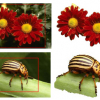Free Online Productivity Tools
i2Speak
i2Symbol
i2OCR
iTex2Img
iWeb2Print
iWeb2Shot
i2Type
iPdf2Split
iPdf2Merge
i2Bopomofo
i2Arabic
i2Style
i2Image
i2PDF
iLatex2Rtf
Sci2ools
ICCV
2009
IEEE
2009
IEEE
Joint optimization of segmentation and appearance models
Many interactive image segmentation approaches use an objective function which includes appearance models as an unknown variable. Since the resulting optimization problem is NP-hard the segmentation and appearance are typically optimized separately, in an EM-style fashion. One contribution of this paper is to express the objective function purely in terms of the unknown segmentation, using higher-order cliques. This formulation reveals an interesting bias of the model towards balanced segmentations. Furthermore, it enables us to develop a new dual decomposition optimization procedure, which provides additionally a lower bound. Hence, we are able to improve on existing optimizers, and verify that for a considerable number of real world examples we even achieve global optimality. This is important since we are able, for the first time, to analyze the deficiencies of the model. Another contribution is to establish a property of a particular dual decomposition approach which involves conve...
| Added | 13 Jul 2009 |
| Updated | 10 Jan 2010 |
| Type | Conference |
| Year | 2009 |
| Where | ICCV |
| Authors | Sara Vicente, Vladimir Kolmogorov, Carsten Rother |
Comments (0)

